
Introduction of Plastic Welding Art
by Alex Lee; Emal:alexlee2696@163.com; Mobile/Wechat/Whatsapp: +86-15918523336
Plastic welding, as a method of plastic parts assembling, applying the common thermoplastic jointing principle,by which two molten thermoplastic parts become re-solidified to achieve jointing under pressure. Comparing to screw fixing assembling, thermoplastic welding is in advantage of air-tightness, and comparing glue sticking, it is in advantage of high joining strength and high production ratio, etc
Thermoplastic jointing normally including thermal type, mechanical type & electromagnetic type. Thermal type plastic welding is kinds of external methods, consists of hot gas welding, hot wedge welding, extrusion welding, hot plate welding, infrared welding and laser welding. Mechanical type is a kinds of internal plastic welding methods, which consists of ultrasonic welding, vibration welding and stir welding. Electromagnetic type is a other kinds of internal plastic method, which mainly consists of resistance / implant / electrofusion welding, induction welding, dielectric welding, microwave welding, etc
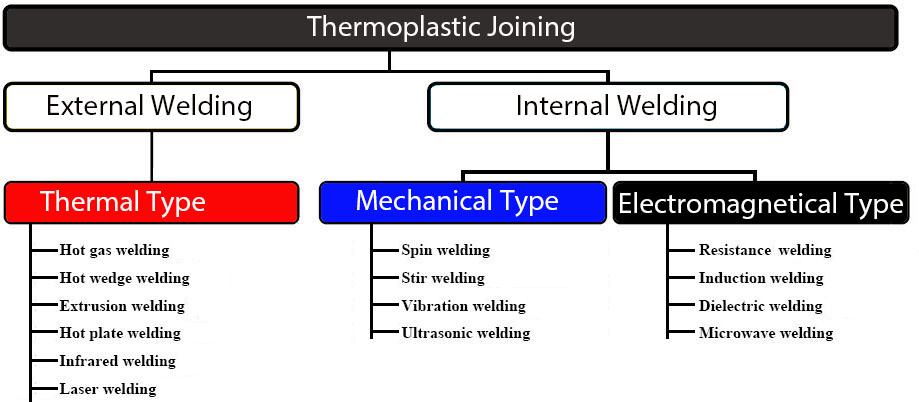
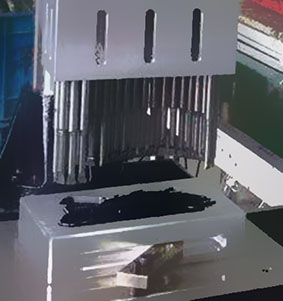 I. Ultrasonic Technology:
I. Ultrasonic Technology:
Normally, the audible frequency of sound to human is from 16KHz to 20KHz, thus we name sound in frequency over than 20KHz as ultrasonic (or ultrasound). However, most animals is more sensitive to sound than human, such as cat which can hear sound in about 64KHz. Reported by “Biology Report”on internet, most kinds of moth can hear sound in frequency as high as 300KHz, then it says that moth has the most sensitive ear. So far as we know that the bat can make sound in frequency about 212KHz,which is more than ten times of that human can hear. The sound made by bat is in ultrasound frequency area.
Read more about ultrasonic welding technique
 II. Vibration Plastic Welding Technology:
II. Vibration Plastic Welding Technology:
Vibration welder use the friction between two thermoplastic connecting parts to melt the plastic, this heat energy comes from the back and forth movement at a certain displacement or amplitude of one Part on another parts’ surface. Once the expected welding extend is reached, the vibration stops with certain pressure still on two Parts, which can cool and solidify the welding part and bond firmly in the end. During vibration welding, one part half is held stationary in a holding fixture while the other part half is frictionally vibrated against it on a linear plane at 150-250Hz under carefully controlled pressure, creating frictional heat at the joining surfaces.
Some of the vibration welding advantages are:
a. Ability to weld parts in big measurement .
b. short cycle times.
c. Compatible with most thermoplastics.
d. Ability to weld several dissimilar materials.
e. No consumables, fumes or emissions.
f. Low cost, quick change tooling.
Read More about Vibration Welding Technique
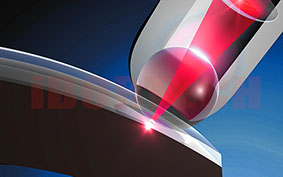 II. Laser Plastic Welding Technology:
II. Laser Plastic Welding Technology:
Laser plastic joining is a kind of transmission welding technology, which applies laser beam with high energy to melt two plastic parts to finish joining under pressure. For laser plastic welding, one parts must be with at least 17% IR (infra-red light) transmittance while the other one must be IR absorptive or coating at the interface to be IR absorptive. During laser plastic welding, the two parts are close under pressure while the laser beam is moving along the joining line in fixed speed. The laser beam passes the transmissible part and be absorbed by the other parts at the welding interface to generate heat and soften the two parts at the interface, then permanent plastic
Laser systems have the following advantages in joining of plastic materials:
a. Cleaner than adhesive bonding
b. No micro-nozzles to get clogged
c. No liquid or fumes to affect surface finish
d. No consumables
e. Higher throughput
f. Can access work-piece in challenging geometry
g. High level of process control
IV. Infrared Plastic welding technology;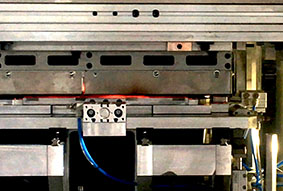
Infrared welding, as a thermal type plastic joining, is a non-contact thermal welding technique achieving strong and air-tight welding to thermoplastic parts. It realizes thermoplastic welding applying infrared radiation, which is a kind of electromagnetic radiation transmitted ultra-high energy in light speed. During infrared plastic joining, two plastic halves are held by jigs and move to be molten by infrared radiation heating, after which the two plastic halves become re-solidified to achieve joining under high pressure.
For thermoplastic joining, the infrared wavelengths reaching plastic welding mostly is medium wavelength (approximately 2.0-2.5uM peak) or short wavelength (approximately 1.0-1.2uM peak).
Comparing to hot plate welding, infrared plastic welding is with advantages of:
1. Cleaning: non-contacting welding, no sticking to tooling by molten plastic material, which is especially good for low temperature plastic joining;
2. Lower power consumption: heating power is on only when plastic melting, while no power consumption for heating during other action steps of cycle time;
3. Higher capacity: infrared can reach heating temperature very soon once power is on, no need to spent time in pre-heating tooling;
4. Can be applied for some thermoplastic material which hot platen welding can not, such as nylon of others material with GF.
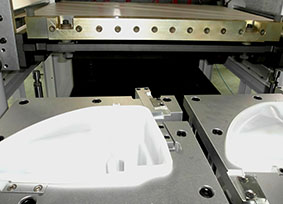 V. Hot Plastic Welding Technology;
V. Hot Plastic Welding Technology;
Hot plate welding is a kinds of thermal plastic welding technique capable of high welding strength and perfect air-tightness plastic joining. It is mostly applied for challenge welding plastic joining in large size and complex geometric design.During hot platen plastic welding, two plastic halves are held by jigs and move to be molten by heating by hot platen, after which the two plastic halves become re-solidified to achieve joining under high pressure.
Mainly advantages of hot platen plastic welding:
a. Ability to weld parts in big measurement and complex geometric shapes and compound contours with little regard to part and joint geometry.
b. High jointing strength especially to welding PP,PE, TPE and EPDM materials.
c. Compatible with most thermoplastics.
d. High strength, hermetic welds are typical.
e. Multiple parts can be welded per cycle time.
f. Relatively low equipment cost.
Nature of the process is simple and highly forgiving of part tolerances when compared with other assembly processes.
Read More about Hot Plate Welding Technique
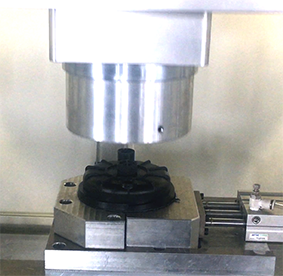 VI. Spin Plastic Welding;
VI. Spin Plastic Welding;
Spin Plastic welding is a kinds of mechanical type welding, apply rotation friction to weld two round thermoplastic Parts, during welding, a Part is fixed on the bottom die, another Part is fixed in rotation of the Part surface motion. Because there is a certain pressure on the two parts, the heat generated by friction between the Parts can melt the surfaces of the two Parts and form a confined and sealed binding. Wherein the positioning rotary melting is rotating at a set time, and instantly stopped at the set position on a permanent fusion. Advantages of spin welding:
a. High welding precision;
b. Fast welding cycle time;
c. Low cost in equipment and tooling;
d Easy welding operation.
Read More about Spin Welding Technique